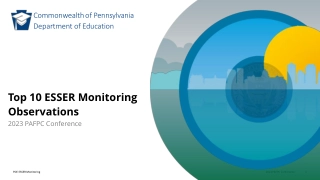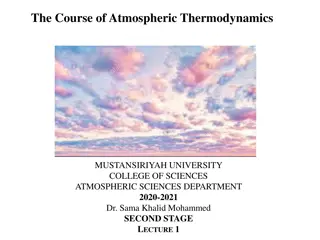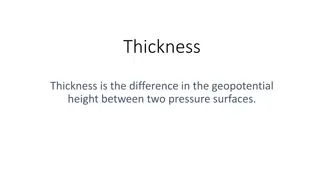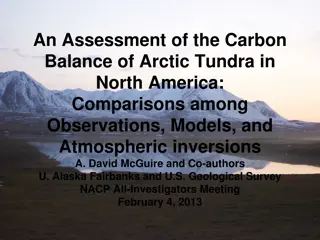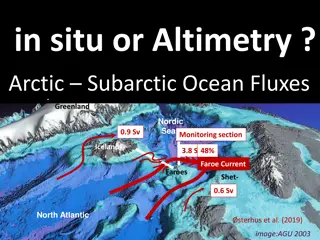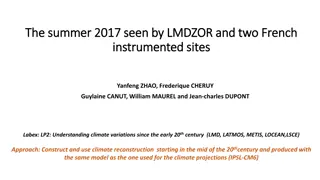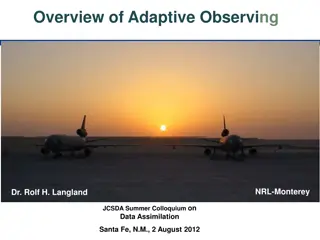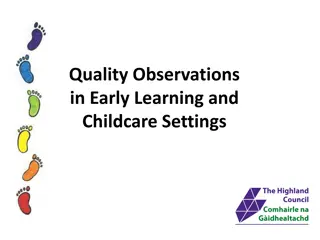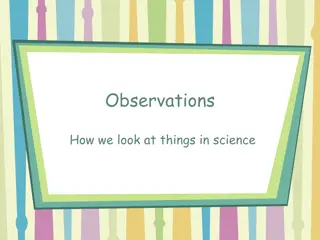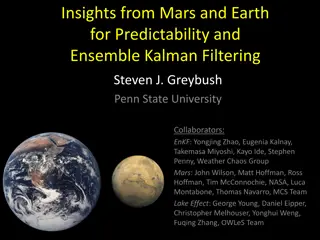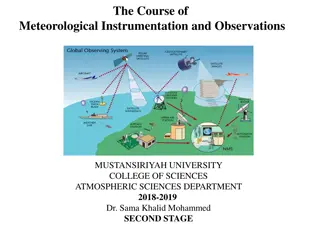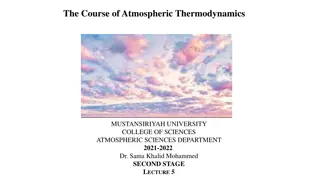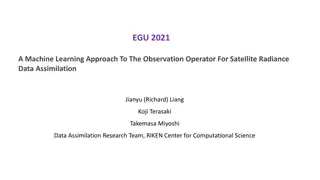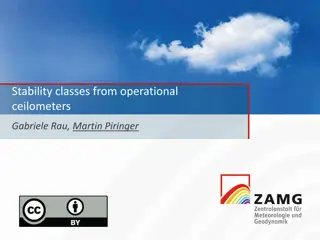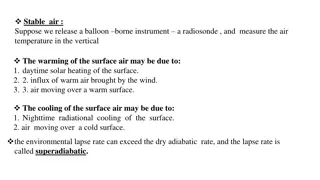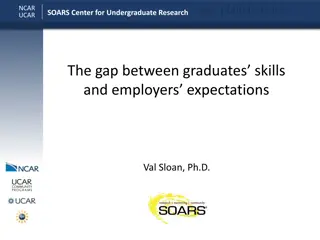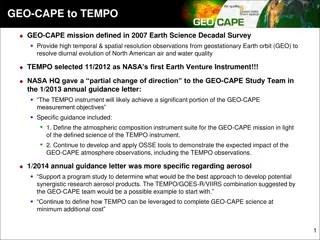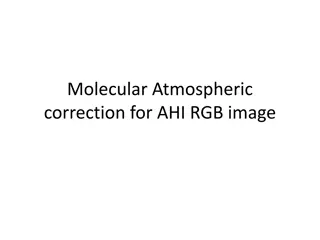Status of Activities Supporting the Space Weather Observations (SWO) Office
The status of activities supporting the Space Weather Observations (SWO) office, including implementation aspects and programs. It also emphasizes the importance of space weather information in various industry sectors and the need for planning follow-on missions for continued observations.
7 views • 26 slides
Understanding Observed Changes in Atmospheric Solar Reflection and Surface Albedo
Exploring the attribution of changes in Earth's Albedo Shortwave Radiation (ASR) to various processes including atmospheric and surface contributions. The impacts of incident solar radiation, cloud reflection, absorption, and surface albedo are analyzed, along with the radiative sensitivity from iso
0 views • 12 slides
Understanding ESSER Monitoring Observations in Pennsylvania Education
Explore the top 10 ESSER monitoring observations from the Commonwealth of Pennsylvania Department of Education. Learn about the structure, content, facilitators, and key areas of review involved in assessing educational programs. Gain insight into how observations play a crucial role in ensuring com
1 views • 42 slides
Understanding Climate Change: Insights from Reed B. Haslam, NYSC Delegate 1972
Reed B. Haslam, an experienced atmospheric scientist, reflects on his early weather observations, noticing the impact of climate change through warming temperatures and reduced precipitation. He emphasizes the key contributors to global warming, such as deforestation and carbon dioxide emissions. Co
1 views • 54 slides
Evaluation of SPLASH and HRRR Soil Moisture Comparison
This study compares soil moisture data between the HRRR model and SPLASH observations during the 2022 warm season. It explores differences in soil moisture levels at various depths, evaluates responses to precipitation events, and drydown periods. The research focuses on analyzed data from HRRR Mode
3 views • 12 slides
Understanding Atmosphere Composition and Structure in Climatology
The study of climatology, focusing on the atmosphere, is presented by Dr. Banashree Saikia, covering topics such as atmospheric composition, insolation, temperature variations, atmospheric pressure, wind systems, atmospheric moisture, climatic classification, cyclones, and monsoons. The atmosphere,
1 views • 9 slides
Understanding Geopotential and Geopotential Height in Atmospheric Thermodynamics
Explore the concept of geopotential and geopotential height in atmospheric sciences, focusing on their significance in understanding gravitational and centrifugal forces on Earth. Learn about the definition, calculation, and applications of geopotential height in relation to atmospheric properties a
1 views • 14 slides
Understanding Atmospheric Moisture in Physical Geography
Atmospheric moisture, in the form of water vapor, liquid water, and ice, plays a crucial role in shaping weather and climate. This course delves into the dynamics of atmospheric moisture, including its distribution, effects on weather patterns, and impact on various climatic factors such as precipit
0 views • 7 slides
Understanding Atmospheric Thickness and Its Applications
Atmospheric thickness refers to the difference in geopotential height between two pressure surfaces, which is dependent on the mean virtual temperature of the layer in between. This concept plays a key role in determining temperature gradients, identifying fronts, and aiding in weather forecasting,
0 views • 11 slides
Understanding Synoptic Meteorology: A Comprehensive Overview
Synoptic meteorology delves into various aspects of atmospheric sciences, encompassing scales of atmospheric motion, weather maps, air masses, fronts, jet streams, and more. Through the study of synoptic meteorology, meteorologists gain insights into interpreting the state of the troposphere and for
1 views • 17 slides
Understanding Atmospheric Pressure Variations at Different Altitudes
Atmospheric pressure varies with altitude due to the weight of the air column above. This activity explores how Otto von Guericke's experiments with vacuum systems demonstrate the power of air pressure. Theoretical concepts of atmospheric pressure are discussed, highlighting its relation to gravity
0 views • 28 slides
Understanding and Addressing Instability in Particle Accelerators
In this document, E. Shaposhnikova from CERN discusses observations and cures for instability in particle accelerators. The content covers types of instabilities, observations like direct and indirect effects, and possible cures such as modifying the source, passive and active damping, and changing
2 views • 30 slides
Carbon Balance of Arctic Tundra in North America: An Overview
This assessment delves into the carbon balance of Arctic tundra in North America, comparing observations, models, and atmospheric inversions. Co-authored by researchers from various institutions, the study analyzes data from 1960 onwards, addressing the changing CO2 sink in high latitudes. It evalua
0 views • 17 slides
Monitoring Faroe Current Transport with Satellite Altimetry and In-situ Observations
Combining satellite altimetry and in-situ observations offers a comprehensive approach to monitoring volume, heat, and salt transports in the Faroe Current. The study focuses on the representativeness of ocean observations in the Arctic and Subarctic regions, highlighting the importance of combining
0 views • 11 slides
Cutting-Edge Atmospheric Chemistry Modeling Research at Barcelona Supercomputing Center
Conducted by the Atmospheric Composition Group at Barcelona Supercomputing Center, this cutting-edge research focuses on atmospheric chemistry modeling using advanced tools and frameworks like HERMESv3 and MONARCH. The team's approach integrates various modules to study complex processes influencing
0 views • 16 slides
Understanding Fluid Statics and Atmospheric Pressure Measurements
Exploring the concept of fluid statics, this content delves into topics such as how atmospheric pressure is measured, buoyancy, and why a steel boat can float. It covers the measurement of pressure, the relationship between pressure and depth in fluids, and demonstrations showcasing these principles
0 views • 24 slides
Insights into Summer 2017 Climate Variations and Heatwave Events
Climate research using climate reconstructions and model simulations for summer 2017, focusing on heatwave periods and temperature anomalies. Observations from instrumented sites and atmospheric soundings were utilized to analyze air temperature, soil moisture, and radiation. The study highlights th
0 views • 22 slides
Overview of Low-Cost Sensors for Atmospheric Composition Measurement
This publication provides an insightful overview of low-cost sensors for measuring atmospheric composition, covering topics like sensor technologies, applications in atmospheric sciences and air quality management, and evaluation methods. It emphasizes the importance of not only the technical perfor
0 views • 17 slides
Understanding Atmospheric Circulation on Earth
An atmospheric circulation driven by temperature differences between the equator and poles influences global weather patterns. The sun's changing angle throughout the year results in various pressure areas and the formation of large circulation cells. The main effects include the transport of humidi
0 views • 11 slides
Sensitivity of Ocean Sampling for Coupled COAMPS-TC Prediction Study
This study explores the optimal ocean sampling strategy for Hurricane Isaac (2012) using high-resolution in-situ observations. It investigates the sensitivity of tropical cyclone intensity change through assimilation of AXBT, AXCTD, and AXCP observations. Results show significant impact areas along
0 views • 12 slides
Adaptive Observing Techniques for Weather Forecasting
This presentation by Dr. Rolf H. Langland explores the concept of adaptive observing in atmospheric applications, focusing on the methodology, field programs, challenges, and objectives of targeted observing. It delves into the optimization problem of determining locations for special atmospheric ob
0 views • 47 slides
Insights into Quality Observations in Early Learning and Childcare Settings
Explore the importance of quality observations in early learning and childcare settings to monitor children's progress and learning. Discover why, what, and how observations are made, along with the criteria for recording and evidencing progress. Learn about different types of observations and why p
0 views • 40 slides
Understanding Observations in Science
Observations in science are essential for gathering data and drawing conclusions. This includes making qualitative and quantitative observations, using senses and tools to increase accuracy, and distinguishing facts from opinions. Inferences are conclusions drawn based on observations and data. Prac
0 views • 13 slides
Understanding the Planetary Boundary Layer in Atmospheric Science
The Planetary Boundary Layer (PBL) plays a crucial role in atmospheric dynamics, divided into surface, mixed, stable, and residual layers. During the day, the mixed layer experiences convective motions due to surface heating, while the stable layer dominates during the night. Understanding these lay
0 views • 18 slides
NSF Atmospheric Chemistry Program Overview
The NSF Atmospheric Chemistry Program aims to characterize the chemical composition of the atmosphere, understand chemical processes, quantify fluxes of chemical substances, study natural and anthropogenic causes of variability, and assess impacts on climate. The program supports research through pe
0 views • 6 slides
Understanding Atmospheric Chemistry Measurements and Methods
Explore the various types of atmospheric chemistry measurements, including research vs. monitoring, gas phase species, satellite vs. in situ observations, and spectroscopy and chromatography methods. Discover how researchers and regulatory bodies use different techniques to study and monitor air qua
0 views • 34 slides
Insights from Mars and Earth for Predictability with Ensemble Kalman Filtering
A collaborative effort between Penn State University and various teams explores the predictability of Martian and Earth weather phenomena using ensemble Kalman filtering. A comparison of key characteristics between Earth and Mars is provided, shedding light on their variable atmospheres and climates
0 views • 31 slides
Meteorological Instrumentation and Observations Overview
Overview of weather maps, symbols, and the weather station model used in meteorological instrumentation and observations. Explains the importance of weather charts in forecasting processes. Also introduces the FM System of Code Forms for reporting weather observations. Helpful resources for students
0 views • 42 slides
Understanding Atmospheric Composition and Structure
The presentation covers fundamental concepts related to the Earth's atmosphere, including its composition, origin of oxygen, dry and moist layers, standard atmosphere layers, and temperature variations. Key topics discussed include the primordial atmosphere, atmospheric constituents, water vapor dis
0 views • 58 slides
Understanding Atmospheric Thermodynamics and Environmental Lapse Rate
Explore the concepts of atmospheric thermodynamics including the Parcel Method, Environmental Lapse Rate, and Conditionally Unstable Atmosphere. Dive into the details of how air parcels behave in different atmospheric conditions and understand the significance of temperature changes in the atmospher
0 views • 27 slides
Machine Learning Approach for Satellite Radiance Data Assimilation
This research explores using machine learning as the observation operator for satellite radiance data assimilation, aiming to improve the efficiency of the process. By training the machine learning model with model output and observations, the study investigates reducing the need for a physically-ba
0 views • 14 slides
GEOS-Chem Atmospheric Chemistry Model Overview
GEOS-Chem, developed by Daniel J. Jacob at Harvard University, is a global model of atmospheric composition used to understand human and natural influences on the environment. The model addresses various atmospheric chemistry issues on different scales, from local to global, and is regularly updated
0 views • 19 slides
Comparison of Cloud Observation Methods for Atmospheric Stability Analysis
Investigating the use of ceilometers to determine stability classes based on cloud cover data, comparing results with human observations. The study aims to assess the feasibility of substituting ceilometer data for human cloud coverage observations in determining atmospheric stability. Results show
0 views • 15 slides
Understanding Atmospheric Stability and Adiabatic Processes
Atmospheric stability is crucial in determining weather conditions. Different processes such as adiabatic cooling play a significant role in the vertical movement of air masses. Understanding the environmental lapse rate, moist and dry adiabatic rates, and the concept of conditional instability help
0 views • 4 slides
Understanding Atmospheric Pressure, Wind Variations, and Humidity in Weather Systems
The atmosphere is composed of various elements like gaseous molecules, water vapor, and dust particles. Key weather variables include atmospheric pressure, temperature, humidity, wind, cloud cover, and precipitation. Atmospheric pressure is influenced by the weight of air above a point, with average
0 views • 17 slides
The DC and AC global atmospheric electric circuits as central tenets in Earth system science today
The presentation at the EGU General Assembly highlighted the significance of DC and AC global atmospheric electric circuits in Earth system science. Key references from 2007 to 2018 underscore the evolving research in this field, exploring the interconnectedness between the space environment and the
0 views • 23 slides
Addressing the Gap Between Graduates' Skills and Employers' Expectations in Atmospheric Geosciences
The article discusses the skills gap in the atmospheric geosciences field, highlighting key technical and communication skills needed by graduates and postgrads. It explores strategies to bridge this gap through surveys, creative solutions, and innovative approaches like updating degree requirements
0 views • 5 slides
Analysis of Atmospheric Parameters and Transmission at OHP in 2018
This analysis focuses on the atmospheric parameters and transmission at the Observatoire de Haute-Provence (OHP) during 2018, with a specific emphasis on distinguishing between typical winter and summer conditions. The study utilizes MERRA2 data from January to August to examine pressure, precipitab
0 views • 16 slides
Evolution of GEO-CAPE: Leveraging TEMPO for Atmospheric Observations
The GEO-CAPE mission, defined in the Earth Science Decadal Survey of 2007, aims to provide high-resolution observations from geostationary Earth orbit to monitor North American air and water quality. NASA's TEMPO instrument, selected in November 2012, plays a crucial role in achieving GEO-CAPE's obj
0 views • 5 slides
Atmospheric Correction Techniques for Satellite Image Enhancement
Atmospheric correction is essential for improving the quality of Remote Sensing images captured by satellites. This process involves correcting for the effects of atmospheric gases such as scattering and absorption on the measured Top-of-Atmosphere (TOA) reflectance. Techniques like molecular correc
0 views • 8 slides


